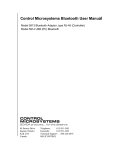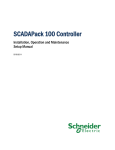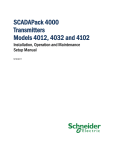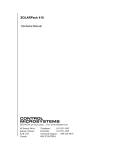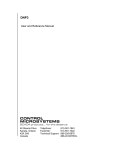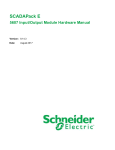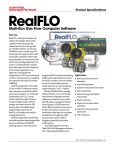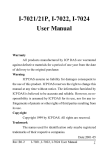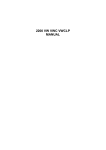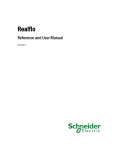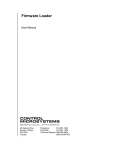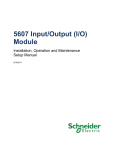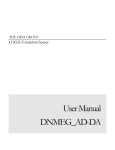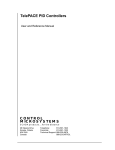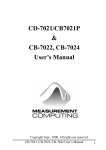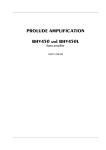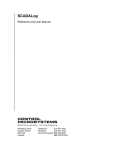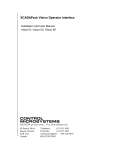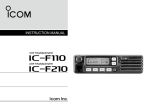Download SCADASense 4203 DR - Control Microsystems
Transcript
SCADASense 4203 DR Installation and User Manual CONTROL MICROSYSTEMS SCADA products... for the distance 48 Steacie Drive Kanata, Ontario K2K 2A9 Canada Telephone: 613-591-1943 Facsimile: 613-591-1022 Technical Support: 888-226-6876 888-2CONTROL SCADASense 4203 DR Series -Installation and User Manual ©2006 Control Microsystems Inc. All rights reserved. Printed in Canada. Trademarks TeleSAFE, TelePACE, SmartWIRE, SCADAPack, TeleSAFE Micro16 and TeleBUS are registered trademarks of Control Microsystems Inc. All other product names are copyright and registered trademarks or trade names of their respective owners. Material used in the User and Reference manual section titled SCADAServer OLE Automation Reference is distributed under license from the OPC Foundation. SCADASense 4203 DR- Installation and User Manual October 19, 2007 1 Table of Contents 1 OVERVIEW .................................................................................................... 6 2 IMPORTANT SAFETY INFORMATION ......................................................... 7 3 INSTALLATION ............................................................................................. 8 3.1 3.1.1 3.1.2 3.1.3 3.1.4 3.1.5 Mounting ................................................................................................... 8 Process-Mounted Transmitter ............................................................. 8 Pipe or Surface-Mounted Transmitter ................................................. 9 Positioning the Transmitter Housing ................................................... 9 Manifold Types and Installation ........................................................... 9 Connections For Sensor Calibration ................................................. 11 3.2 3.2.1 Optional Display Module ......................................................................... 12 Adding the Optional Display .............................................................. 12 3.3 Transmitter Wiring .................................................................................. 13 3.4 3.4.1 3.4.2 Power Supply.......................................................................................... 15 Fusing................................................................................................ 15 System Grounding............................................................................. 16 3.5 Internal Analog Input .............................................................................. 16 3.6 RTD Input ............................................................................................... 17 3.7 3.7.1 3.7.2 3.7.3 3.7.4 Analog Output ......................................................................................... 19 Current Outputs ................................................................................. 20 Voltage Outputs................................................................................. 20 Analog Outputs Data Format ............................................................. 20 Digital Output Control with External Relay ........................................ 20 3.8 3.8.1 3.8.2 3.8.3 Digital I/O and Counters ......................................................................... 21 Turbine Meter Counter Input - CTR1 ................................................. 22 Counter / Digital Input - CTR0/DIN/DOUT ......................................... 22 Digital Output - CTR0/DIN/DOUT ...................................................... 22 4 4.1 4.1.1 4.1.2 4.1.3 SERIAL COMMUNICATION ........................................................................ 24 RS-232 Serial Communications Ports .................................................... 24 RS-232 Wiring Examples .................................................................. 24 COM1 RS-232 Serial Port Settings ................................................... 25 COM2 RS-232 Serial Port Settings ................................................... 25 SCADASense 4203 DR- Installation and User Manual October 19, 2007 2 4.1.4 COM3 RS-232 Serial Port Settings ................................................... 26 4.2 4.2.1 4.2.2 4.2.3 4.2.4 4.2.5 RS-485 Serial Communications Ports .................................................... 26 RS-485 Wiring Examples .................................................................. 27 RS-485 Bias Resistors ...................................................................... 27 RS-485 Termination Resistors .......................................................... 27 COM2 RS-485 Serial Port Settings ................................................... 28 COM3 RS-485 Serial Port Settings ................................................... 28 5 OPERATION ................................................................................................ 30 5.1 5.1.1 5.1.2 5.1.3 5.1.4 Operating Modes .................................................................................... 30 Run Mode .......................................................................................... 30 Service Mode .................................................................................... 30 Sensor Mode ..................................................................................... 31 Cold Boot Mode................................................................................. 31 5.2 5.2.1 LED Status Indicator ............................................................................... 32 LED Power Control ............................................................................ 32 6 MODBUS REGISTER MAPPING ................................................................ 33 6.1 Write Protect Jumper .............................................................................. 33 6.2 Software Write Protect ............................................................................ 33 6.3 Data Formats .......................................................................................... 33 6.4 6.4.1 6.4.2 Modbus Registers ................................................................................... 34 Default Parameters ........................................................................... 51 Display Module ASCII Characters ..................................................... 52 7 MAINTENANCE ........................................................................................... 54 7.1 Lithium Battery ........................................................................................ 54 7.2 Rotating Process Covers for Venting ...................................................... 54 8 TROUBLESHOOTING ................................................................................. 56 8.1 Analog Output ......................................................................................... 56 8.2 Digital Input ............................................................................................. 56 8.3 Digital Output .......................................................................................... 56 8.4 Counter Inputs ........................................................................................ 56 SCADASense 4203 DR- Installation and User Manual October 19, 2007 3 9 SPECIFICATIONS ....................................................................................... 57 9.1 General ................................................................................................... 57 9.2 Controller ................................................................................................ 57 9.3 Communications ..................................................................................... 57 9.4 Visual Indicators ..................................................................................... 58 9.5 Power Supply.......................................................................................... 58 9.6 Analog Input ........................................................................................... 58 9.7 Analog Output ......................................................................................... 58 9.8 Turbine Meter Counter Input................................................................... 59 9.9 Digital Counter Input ............................................................................... 59 9.10 Digital Output .......................................................................................... 59 9.11 Transmitter Functional Specifications ..................................................... 60 9.12 Transmitter Temperature Specifications ................................................. 61 9.13 Transmitter Performance Specifications ................................................. 62 9.14 Transmitter Physical Specifications ........................................................ 63 9.15 9.15.1 Approvals and Certifications ................................................................... 65 ATEX/IECEx label ............................................................................. 65 9.16 Dimensions ............................................................................................. 66 Index of Figures Figure 1: Process-Mounted GFC ........................................................................................ 8 Figure 2: Mounting the SCADASense 4203 DR Series to a Pipe or Surface ....................... 9 Figure 5: PGI-M573 Five Valve Manifold ............................................................................10 Figure 6: PGI-M673 Five Valve Manifold ............................................................................10 Figure 7: Differential Pressure Calibration Connections .....................................................11 Figure 8: Absolute Pressure Calibration Connections ........................................................11 Figure 3: Optional Display and Write Protect Jumper.........................................................13 Figure 4: Accessing Field Terminals ..................................................................................14 Figure 5: Terminal Board Layout ........................................................................................15 Figure 6: Input Power Wiring with External Fuse ...............................................................16 Figure 7: Input Power Wiring with Internal Fuse.................................................................16 Figure 8: Transmitter 4-Wire RTD Wiring...........................................................................17 Figure 9: Transmitter 3-Wire RTD Wiring...........................................................................17 Figure 11: Analog Output Wiring ........................................................................................19 Figure 12: DC Digital Output Wiring Example ....................................................................21 Figure 13: AC Digital Output Wiring Example ....................................................................21 Figure 14: Digital and Counter Input Wiring .......................................................................22 SCADASense 4203 DR- Installation and User Manual October 19, 2007 4 Figure 15: Digital Output Wiring Example ..........................................................................23 Figure 16: COM2 RS-232 Wiring .......................................................................................24 Figure 17: COM3 RS-232 Wiring .......................................................................................25 Figure 18: COM2 RS-485 Wiring .......................................................................................27 Figure 19: COM3 RS-485 Wiring .......................................................................................27 Figure 20: Sensor Cavity Venting and Draining ..................................................................55 Index of Tables Table 1: Data Format .........................................................................................................33 Table 2: Modbus Registers ................................................................................................34 Table 3: SCADASense 4203 DR -Default Parameters .......................................................52 Table 4: Display Module ASCII Characters ........................................................................52 SCADASense 4203 DR- Installation and User Manual October 19, 2007 5 1 Overview The SCADASense 4203 DR1 is a two meter run flow computer with an integrated multivariable sensor. The transmitter is supplied with a pre-configured gas flow application and can also be programmed in TelePACE Relay Ladder Logic, compiled C, and IEC 61131-3. The SCADASense 4203 DR transmitter provides a discrete input/output that can be used as status input, or as a high frequency counter input or a sinking digital output. A second high frequency counter input accepts low-level inputs from devices such as turbine meters. Standard analog output provides flexible control for variable speed motor drives, control valves, emergency shutdowns, or whatever your site requires. The applied power source voltage is internally monitored and available for communication to the SCADA host. These SCADASense 4203 DR transmitters provide a Modbus mapping of all transmitter functions that is compatible with the Rosemount 3095FB MVT. The transmitter can be used with or without the flow computer program. This DR Series Gas Flow Computers (GFC’s) provide two fully functional RS-232/485 selectable serial ports. Either or both ports can be used with remote I/O, radios, local displays, or other serial devices. Either of the two provided serial ports can be used to communicate with another member of the SCADAPack family for I/O expansion. The SCADASense 4203 DR transmitter provides Modbus master/slave and EFM Modbus as its native protocols. DNP 3.0 protocol is optionally available. Custom protocols can be implemented using C programming. These transmitters can optionally be configured using the SCADASense 4000 Series Configurator UI, which is shipped on an accompanying Configuration CD. The SCADASense 4000 Series Configurator supports the configuration, monitoring, and calibration of all SCADASense 4000 Series transmitters. 1 Also referred to as Gas Flow Computer (GFC) or simply transmitter SCADASense 4203 DR- Installation and User Manual October 19, 2007 6 2 Important Safety Information Power, input and output (I/O) wiring must be in accordance with Class I, Division 2 wiring methods Article 501-4 (b) of the National Electrical Code, NFPA 70 for installations in the U.S., or as specified in Section 18-1J2 of the Canadian Electrical Code for installations within Canada and in accordance with the authority having jurisdiction. WARNING ! EXPLOSION HAZARD - SUBSTITUTION OF COMPONENTS MAY IMPAIR SUITABILITY FOR CLASS 1, DIVISION 2. WARNING ! EXPLOSION HAZARD – WHEN IN HAZARDOUS LOCATIONS, TURN OFF POWER BEFORE REPLACING OR WIRING MODULES. WARNING ! EXPLOSION HAZARD - DO NOT DISCONNECT EQUIPMENT UNLESS POWER HAS BEEN SWITCHED OFF OR THE AREA IS KNOWN TO BE NONHAZARDOUS. SCADASense 4203 DR- Installation and User Manual October 19, 2007 7 3 3.1 Installation Mounting The transmitter can be supported by the process piping as shown in Figure 1 or mounted to a vertical or horizontal pipe or surface using the optional mounting bracket shown in Figure 2. Note: If the GFC is not installed in the vertical position as shown in Figure 1 or Figure 2, readjust zero output to eliminate the position zero effect. The GFC should be mounted so that any moisture condensing or draining into the field-wiring compartment can exit through one of the two threaded conduit connections. CAUTION ! To avoid damage to the GFC sensor, do not use any impact devices, such as an impact wrench or stamping device, on the transmitter. Note: 3.1.1 Use a suitable thread sealant on all connections. Process-Mounted Transmitter Figure 1 shows a SCADASense 4203 DR transmitter mounted to and supported by the process piping. Figure 1: Process-Mounted GFC SCADASense 4203 DR- Installation and User Manual October 19, 2007 8 3.1.2 Pipe or Surface-Mounted Transmitter To mount the transmitter to a pipe or surface, use the Optional Mounting Bracket Set (Model Code Option -M). Referring to Figure 2, secure the mounting bracket to the transmitter using the two lock washers and screws provided. Mount the GFC with mounting bracket to a vertical or horizontal, DN 50 or 2-in pipe. To mount to a horizontal pipe, turn the U-bolt 90o from the position shown in Figure 2. The mounting bracket can also be used for wall mounting by securing the bracket to a wall using the U-bolt mounting holes. Figure 2: Mounting the SCADASense 4203 DR Series to a Pipe or Surface 3.1.3 Positioning the Transmitter Housing The SCADASense 4203 DR housing (top works) can be rotated up to one full turn in the counterclockwise direction when viewed from above for optimum access to adjustments, display, or conduit connections. Note: Do not rotate the housing more than one turn from the “as received” position. If there is doubt about the housing rotational position, turn fully clockwise and then back off no more than one full turn. WARNING: The small setscrew on the housing keeps the housing from being rotated too far. This is NOT a locking screw. Do not tamper with this screw. Damage to the housing can occur if this setscrew is tampered with. 3.1.4 Manifold Types and Installation Several manifold models are available to interface a transmitter with the process piping. The PGIM573 has ½” FNPT inlets and ½” FNPT outlets, while the PGI-M673 has ½” FNPT inlets and SCADASense 4203 DR- Installation and User Manual October 19, 2007 9 Instrument Flange outlets. Two options are available. The CDT option is of carbon steel construction while the SDJ option uses 316SS NACE construction (140F max) and has a fluorosilicone stem seal. Figure 3: PGI-M573 Five Valve Manifold Figure 4: PGI-M673 Five Valve Manifold The bolts to mount the PGI-M673 model to the sensor are 7/16-20 x 1” SCADASense 4203 DR- Installation and User Manual October 19, 2007 10 3.1.5 Connections For Sensor Calibration It should be noted that when an Absolute (Static) Pressure calibration is performed the bypass or cross feed valve on the manifold must be open. When performing a Differential Pressure calibration the bypass valve must be closed. Figure 5: Differential Pressure Calibration Connections Figure 6: Absolute Pressure Calibration Connections SCADASense 4203 DR- Installation and User Manual October 19, 2007 11 3.2 Optional Display Module The optional display module is used to provide local display of meter run data. The display may be configured using the SCADASense 4000 Series Configurator, RealFLO, Flow Computer commands, or Modbus Register Mapping. The data to display and the interval between the displayed items is user defined. The SCADASense 4000 Series Configurator is installed from the Hardware Documentation CD. When installed on your PC, it is found in the Windows || Programs || Control Microsystems || 4000 Series program group. Refer to the online help document of this program for additional assistance in configuring your transmitter display. The SCADASense series of transmitter can also be configured using the RealFLO application. Refer to the MVT Configuration commands section of the RealFLO User and Reference manual for complete information on using RealFLO to configure the Display Module. The Display Control Configuration section of the TeleBUS Protocol Section of the RealFLO User and Reference manual provides the information for using the Display Module with Flow Computer commands. The Modbus Register Mapping section of this manual contains information on configuring the Display Module using Modbus registers. Note: 3.2.1 Configuring a SCADASense transmitter using the local display is possible with older transmitters only. See the application note “Configuring an older SCADASense transmitter using the Local Dsplay.pdf”, located in the same directory as this document, for a detailed procedure. Newer SCADASense transmitters no longer have this configuration menu available off the local display, and have to be configured using other means as noted above. If you cannot access the menu, it is not available on your transmitter version. Adding the Optional Display To add the optional display, refer to Figure 7 and proceed as follows: 1. 2. 3. 4. 5. 6. Turn off the transmitter power source. Remove the electronics compartment cover by rotating it counterclockwise. Screw in the cover lock if applicable. Plug the display into the receptacle at the top of the electronics assembly. Ensure that the O-ring is seated in its groove in the display housing. Then insert the display into the electronics compartment by grasping the two tabs on the display and rotating it approximately 10° in a clockwise direction. Install the new cover (with a window) onto the housing by rotating it clockwise until the O-ring contacts the housing; then continue to hand tighten it as much as possible (at least 1/4 turn). If cover locks are present, align the serration in the cover with the lock and unscrew the lock until it extends into the cover serration to prevent unwanted cover rotation. Turn on the transmitter power source. 3.2.1.1 Write Protect Jumper The write protect jumper is located to the right of the display connector as shown in figure 3. The jumper is used to connect two of the three pins on the write protect header. Connecting the top two pins with the jumper disables the write protection. SCADASense 4203 DR- Installation and User Manual October 19, 2007 12 Connecting the bottom two pins with the jumper enables the write protection. See the Write Protect Jumper section for information on the effects of the Write Protect jumper. Jumper on top two pins DISABLES write protection Display Connector Jumper on bottom two pins ENABLES write protection Figure 7: Optional Display and Write Protect Jumper The optional display can be rotated within the housing to any of four positions at 90° increments. To do this, grasp the two tabs on the display and rotate it about 10° in a counterclockwise direction. Pull out the display. Ensure that the O-ring is fully seated in its groove in the display housing. Turn the display to the desired position, reinsert it in the electronics module, aligning the tabs on the sides of the assembly, and twist it in the clockwise direction. 3.3 Transmitter Wiring The installation and wiring of the GFC must conform to local code requirements. Note for North America: Seal not required when installed with rigid conduit per requirements of the applicable electrical code. When using instrument cable approved for the hazardous location, a seal must be made with an approved cable gland or conduit seal per the requirements of the applicable electrical code. SCADASense 4203 DR- Installation and User Manual October 19, 2007 13 Note for ATEX IECEx: Seal required when installed with rigid conduit per requirements of the applicable electrical code. When using instrument cable approved for the hazardous location, a seal must be made with an approved cable gland or conduit seal per the requirements of the applicable electrical code. For access to the field terminals, thread the cover lock (if present) into the housing to clear the threaded cover and remove the cover from the field terminals compartment as shown in Figure 8. Note that the embossed letters FIELD TERMINALS identify the proper compartment. Figure 8: Accessing Field Terminals The GFC uses screw termination style connectors for termination of field wiring. These connectors accommodate solid or stranded wires from 16 to 28 AWG. The connectors are removable for field service and replacement purposes. Leave enough slack in the field wiring for the connector to be removed. Note: The use of transient/surge protection is recommended in installations prone to high levels of electrical transients and surges. CAUTION ! Remove power before servicing unit. CAUTION ! The transmitter threaded end cap with the terminal board wiring diagram must be installed on the housing end that has the terminal board. This is a Class Div. 2 Hazardous Locations requirement. There are five connectors for field wiring. Refer to Figure 9: Terminal Board Layout for connector locations. Connector pinouts and wiring examples are described in each of the respective sections of this manual. SCADASense 4203 DR- Installation and User Manual October 19, 2007 14 Status LED AOUT DC Power (+) Input Power Connections DC Power (-) COM2 RS-232 or 485 Connections P1 COM 2 TX / A+ COM 2 RX / B– F U S E CTR 1 Analog Output, Digital Input/Output and Counter Input Connections COM P5 CTR0/DIN/DOUT COM 2 com COM3 RS-232 or 485 Connections I P2 COM 2 (232 / 485) COM 3 (232 / 485) COM 3 TX / A R COM 3 RX / B R COM 3 com P3 P4 RTD Connections IRET Cold Boot Switch Figure 9: Terminal Board Layout 3.4 Power Supply The SCADASense 4203 DR is powered from a 9 to 30VDC input power source. Input power is applied to the +PWR and –PWR terminals on connector P1. Refer to section 9- Specifications of this manual for the minimum and maximum operating voltages and input power requirements. When the input voltage is below the minimum recommended voltage the GFC will turn off. Exceeding the maximum input voltage or applying a reverse voltage may damage the GFC. External Fusing is recommended on early production of these models. 3.4.1 Fusing The SCADASense 4203 DR requires fusing on the power supply inputs. This fusing is included on the terminal board. The fuse is located between connectors P1 and P5. These connectors must be removed to have access to the fuse. The replacement fuse is a Littelfuse R452.750 for the transmitter. See Figure 11: Input Power Wiring with Internal Fuse. Littelfuse R452.750 is available from Control Microsystems as part number 200094. Note: External Fusing is recommended on early production DR Series GFC’s. Use a 0.75A Slow Blow Fuse for the SCADASense 4203 DR as shown in Figure 10: Input Power Wiring with External Fuse. SCADASense 4203 DR- Installation and User Manual October 19, 2007 15 + 0.5A/0.75A Slow Blow Fuse + Power 1 – Power 2 Power Supply P1 – Note: See text for fuse recommendations and power supply requirements. Figure 10: Input Power Wiring with External Fuse P1 + Power Supply + Power 1 – Power 2 – F U S E Note: See text for power supply requirements. Figure 11: Input Power Wiring with Internal Fuse 3.4.2 System Grounding The SCADASense 4203 DR circuitry is electrically isolated from the housing for voltages up to 550Vac. All terminal board connections labeled COM on connectors P2, P3 and P5 are tied together and connected to –PWR on the input power terminal block P1. The Serial Communication Ports, Counter/Digital Inputs, Analog Outputs and Input Power all share the same electrical common. 3.5 Internal Analog Input A SCADASense 4203DR Series transmitter has one internal analog input. These internal analog inputs are accessed from the user application program. The analog input monitors the supply voltage. The analog input returns 16-bit integer values. Valid values are 0 to 32700. The input value is scaled to represents the voltage in mV with 100mV resolution. For TelePACE applications use: The 4203 DR/4202 DR Extended I/O module register assignment to read the supply voltage in mV on a SCADASense 4203 DR. SCADASense 4203 DR- Installation and User Manual October 19, 2007 16 For ISaGRAF applications use: 3.6 The ss4203dr complex equipment to read the supply voltage in mV on a SCADASense 4203 DR. RTD Input The SCADASense 4203 DR requires a connection to an RTD. A 4-wire connection to the RTD is recommended for the highest accuracy. Refer to Figure 12: Transmitter 4-Wire RTD Wiring for wiring information for 4-Wire RTDs to the transmitter. 4 3 2 1 I Excite RTD RTD I Return RTD P4 Figure 12: Transmitter 4-Wire RTD Wiring A 3 wire RTD can be used with a minimal reduction in accuracy in the transmitter. When using 3 wire RTDs run 4 wires as long as possible from the terminal board to the RTD. See Figure 13 for wiring information for 3-Wire RTDs to the transmitter. 4 3 2 1 RTD RTD/Exicite RTD I Return P4 Figure 13: Transmitter 3-Wire RTD Wiring A 3 wire RTD can be used with the SCADASense 4203 DR. The transmitter RTD circuitry will compensate for the resistance in the connection to pin 3. See Figure 13 for wiring information for 3Wire RTDs on the transmitter. SCADASense 4203 DR- Installation and User Manual October 19, 2007 17 The transmitter RTD inputs have been declared as non-incendive for use in Class 1 Div. 2 Hazardous locations. Ordinary wiring methods can be used in accordance with the NEC and CEC. SCADASense 4203 DR- Installation and User Manual October 19, 2007 18 3.7 Analog Output The SCADASense 4203 includes one 0-20mA current sinking analog output. The analog output is a sinking type in the sense that it limits the current flowing through its terminals to 0-20mA. When a value of 0 is written to the D/A converter, the analog output allows 0mA of current flow through its terminals. When a value of 32760 is written to the D/A converter, the analog limits the current flow through its terminals to 20mA. Given that the analog output is referenced to a power source, these currents have to be provided through an external load. Refer to the appropriate software manual for information on using the analog output in an application programs. For TelePACE and ISaGRAF applications refer to the Register Assignment or I/O Complex Equipment respectively, for the controller. When a sinking analog output is wired to an external device care must be taken to ensure the operating characteristics of the analog output are considered. As can be seen in Figure 14: Analog Output Wiring the LOAD does not connect to ground at any point. The LOAD must be able to float above ground in order for the analog output to function. The analog output must be connected to a differential input device For example, in the wiring example shown in Figure 10, the points A and B will each be at a positive voltage based on the sinking current output, the LOAD resistance and the Power Supply voltage. For a sinking current of 0 mA, a LOAD resistance of 250 Ohms and a power supply voltage of 24VDC the voltage at both A and B points is 24VDC. For a sinking current of 20 mA, a LOAD resistance of 250 Ohms and a power supply voltage of 24VDC the voltage at point B is 24VDC and the voltage at point A is 24VDC minus 5VDC (20 mA x 250 Ohms) or 19VDC. NOTE: The LOAD cannot be connected to ground in any wiring configuration for the analog output. A B P5 4 AOUT 2 COM – LOAD + + Power Supply – Note: See specifications for load resistance range and power supply limits. Figure 14: Analog Output Wiring SCADASense 4203 DR- Installation and User Manual October 19, 2007 19 3.7.1 Current Outputs The analog output is a sinking output that is not ground referenced. The load connects between connector P5, pin 4 and a positive power supply as shown in Figure 14: Analog Output Wiring. Refer the Specifications section for power supply limits and load resistance ranges. 3.7.2 Voltage Outputs To obtain voltage outputs, connect a load resistor in the current output. Connect the voltage device across the load resistor. The table below list resistance values and output range settings for two common voltage ranges. The resistance value listed is the parallel resistance of the device and the load resistor. 3.7.3 Voltage Range Resistance Output Range 0 to 5V 250 0-20mA 0 to 10V 500 0-20mA Analog Outputs Data Format The analog output has a 12-bit, unipolar, digital to analog converter. There are 4096 counts in the output signal range. The 0-20mA output range resolution is 4.88µA/count. The table below shows the output current for several D/A values. Given that the analog output is referenced to a power source, these currents have to be provided through a load. 3.7.4 D/A Value Current 0 8 6552 16384 24576 32760 0mA 4.88µA 4mA 10mA 15mA 19.995mA Digital Output Control with External Relay The analog output can be used to control an external relay. Electromechanical or solid state relays that meet the output requirements of the analog output can be used. An example of AC and DC digital outputs is shown using solid state relay modules. These examples use DIN rail mounted output modules from Crouzet/Gordos. These modules have a 4-32VDC input range. Turn OFF an output module by writing 0 to the Analog Output. Turn ON an output module by writing 32767 (20mA) to the Analog Output. Lower currents can be used to save power. Refer to the relay specifications for the input requirements for the selected relay. Model 84130104 is a 5-60VDC, 3A DC output module with integrated fuse. Refer to Figure 15: DC Digital Output Wiring Example for wiring details. SCADASense 4203 DR- Installation and User Manual October 19, 2007 20 Solid State Relay +3 + 1+ – LOAD (A) + +VDC + LOAD (B) – –VDC 84130104 5-60VDC, 3A Input DC Output Module Output 9-30VDC Power Supply –4 2– – P5 4 AOUT 2 Notes: Load may be wired in location A or B. DC inductive loads must be diode suppressed. COM Figure 15: DC Digital Output Wiring Example Model 84130105 is a 12-280VAC, 5A AC output module with integrated fuse. Refer to Figure 16: AC Digital Output Wiring Example for wiring details. Solid State Relay + 9-30VDC Power Supply +3 1+ LOAD (A) VAC Hot LOAD (B) VAC Neutral 84130105 12-280VAC, 5A Input AC Output Module Output –4 2– – P5 4 AOUT Note: Load may be wired in location A or B. 2 COM Figure 16: AC Digital Output Wiring Example 3.8 Digital I/O and Counters The SCADASense 4203 DR has a turbine meter counter input identified as CTR1. Counter input CTR1 includes a built in pre-amplifier and is designed to work with turbine meter inputs. This counter input operates as a counter only. SCADASense 4203 DR- Installation and User Manual October 19, 2007 21 In addition to the turbine meter input the SCADASense 4203 DR has a multi-purpose counter input and digital input/output connection identified as CTR0/DIN/DOUT. The CTR0/DIN/DOUT counter / input is used with open collector or drain output devices, relay contacts or switches. The CTR0/DIN/DOUT digital output is an open drain (sinking) digital output. Refer to the appropriate software manual for information on using counter Inputs in application programs. For TelePACE applications and ISaGRAF applications, refer to the Register Assignment and I/O Complex Equipment respectively for the GFC. P5 3 2 1 CTR1 COM Turbine Meter Sensor CTR0/DIN/DOUT Note: Counter 0 is shown as a relay or switch contact. Counter 1 is shown as a turbine meter sensor. Figure 17: Digital and Counter Input Wiring 3.8.1 Turbine Meter Counter Input - CTR1 The SCADASense 4203 allows for the direct connection to one turbine meter sensor. These sensors produce millivolt outputs and do not require an external pre-amplifier when used with the GFC. The turbine meter input can be used in low noise environments with shielded cabling. Counter 1 is shown with a direct connection to a turbine meter sensor. Shielded wiring must be used and the shield should be connected at one end only. There is an enclosure ground connection that can be used for this purpose. 3.8.2 Counter / Digital Input - CTR0/DIN/DOUT The counter/digital input is used to count or monitor contact closures and open collector/drain devices. The input circuitry provides 5mA of wetting current for the contact. Refer to Figure 17: Digital and Counter Input Wiring for examples of wiring to this input. This input shares a Common with CTR1. The CTR0/DIN/DOUT counter digital input is a high-speed input. Ensure that the applied input is free of contact bounce. 3.8.3 Digital Output - CTR0/DIN/DOUT The CTR0/DIN/DOUT is an open drain (sinking) digital output. The output is typically used to control 12VDC to 24VDC loads with currents up to 500mA. The positive side of the load connects to a +ve (30VDC maximum) power supply. The negative side of the load connects to connector P5, 1. Refer to Figure 18: Digital Output Wiring Example for wiring details. SCADASense 4203 DR- Installation and User Manual October 19, 2007 22 + 9-30VDC Power Supply – P5 2 COM 1 DOUT – LOAD + Figure 18: Digital Output Wiring Example SCADASense 4203 DR- Installation and User Manual October 19, 2007 23 4 Serial Communication The SCADASense 4203 DR is equipped with two serial communication ports for user interface to the controller. Both serial communication ports support RS-232 serial communication and RS-485 serial communication. In addition to these two serial ports these GFC’s have an internal serial port defined as COM1. This serial port is not assessable by users and is used for communication between the controller and the sensor. User serial ports on the transmitter are designated COM2 and COM3. Connections to COM2 and COM3 are made using removable 3 position terminal blocks. 4.1 RS-232 Serial Communications Ports Both COM2 and COM3 are capable of RS-232 operation. RS-232 operation is selected by installing the appropriate jumper link on the terminal board labeled COM2 and COM3. RS-232 operation uses RxD, TxD and COM signals. Refer to Figure 19: COM2 RS-232 Wiring and Figure 20: COM3 RS-232 Wiring for connector wiring descriptions. NOTES: The low power transmitters used in COM2 and COM3 generate 0 to 5V levels. This is less than the RS-232 specification but still compatible with all RS-232 receivers. Cables should be limited to a maximum of 10 ft (3m). Shielded cable should be used to protect the signals from noise and to comply with FCC and CE regulatory requirements. The shield is connected to Ground at one end only. 4.1.1 RS-232 Wiring Examples RS-232 9 Pin D connector DTE 2 RxD 3 TxD 5 COM TxD RxD COM P2 1 2 3 COM2 Note: DIP Switch set to the RIGHT on COM2 for RS-232 operation. Figure 19: COM2 RS-232 Wiring SCADASense 4203 DR- Installation and User Manual October 19, 2007 24 Note: DIP Switch set to the RIGHT on COM3 for RS-232 operation. RS-232 9 Pin D connector DTE COM3 TxD RxD COM 2 RxD 3 TxD 5 COM 1 2 3 P3 Figure 20: COM3 RS-232 Wiring 4.1.2 COM1 RS-232 Serial Port Settings The following table shows the serial and protocol communication parameters supported by COM1. These parameters are fixed and cannot be changed by users. 4.1.3 Parameter Supported Values Baud Rate Duplex Parity Data Bits Stop Bits Receive Flow Control Transmit Flow Control Protocol 4800 Full None 8 Bits 1 Bit None None Sensor COM2 RS-232 Serial Port Settings The following table shows the serial and protocol communication parameters supported by COM2. These parameters are set from TelePACE, ISaGRAF Workbench or from an application program running in the controller. Default values are set when a Cold Boot or Service Boot is performed on the controller. Parameter Supported Values Baud Rate 300, 600, 1200, 2400, 4800, 9600, 19200, 38400, 57600 and 115200 Default: 9600 Full and Half Default: Half Odd, None or Even Default: None 7 or 8 Bits Default: 8 Bits 1 or 2 Bits Default: 1 Bit None None 1 to 65534 Default: 1 Duplex Parity Data Bits Stop Bits Receive Flow Control Transmit Flow Control Station SCADASense 4203 DR- Installation and User Manual October 19, 2007 25 Parameter Supported Values Protocol None, Modbus RTU or Modbus ASCII, DF1 and DNP. Default: Modbus RTU Standard or Extended Default: Standard Addressing Mode 4.1.4 COM3 RS-232 Serial Port Settings The following table shows the serial and protocol communication parameters supported by COM3. These parameters are set from TelePACE, ISaGRAF Workbench or from an application program running in the controller. Default values are set when a Cold Boot or Service Boot is performed on the controller. Parameter Supported Values Baud Rate 300, 600, 1200, 2400, 4800, 9600, 19200, 38400, 57600 and 115200 Default: 9600 Full and Half Default: Half Odd, None or Even Default: None 7 or 8 Bits Default: 8 Bits 1 or 2 Bits Default: 1 Bit ModbusRTU Default: ModbusRTU Ignore CTS or None Default: None 1 to 65534 Default: 1 None, Modbus RTU or Modbus ASCII, DF1 and DNP. Default: Modbus RTU Standard or Extended Default: Standard Duplex Parity Data Bits Stop Bits Receive Flow Control Transmit Flow Control Station Protocol Addressing Mode 4.2 RS-485 Serial Communications Ports Both COM2 and COM3 are capable of 2 wire RS-485 operation. RS-485 operation is selected by removing the appropriate jumper link on the terminal board labeled COM2 and COM3. RS-485 operation uses A+ and B– signals. Refer to Figure 21: COM2 RS-485 Wiring and Figure 22: COM3 RS-485 Wiring for connector wiring descriptions. RS-485 uses balanced differential signals. Proper RS-485 operation requires that all devices communicating on the signal pair be referenced to the same point. In the transmitter, this reference point is established by the devices connected to the Power Input and I/O. The incoming power (– PWR on P1,1) will generally establish the reference point. The RS-485 serial communication ports transmit and receive differential voltages to other RS-485 devices on a network. The RS-485 specification allows a maximum of 32 devices connected on a single RS-485 network. The specification for RS-485 recommends that the cable length should not exceed a maximum of 4000 feet or 1200 meters. Termination resistors are required when using long cable lengths and high baud rates. Refer to section 4.2.3-RS-485 Termination Resistors for information on termination resistors. The signal grounds of the RS-485 devices in the network are not connected together but instead are referenced to their respective incoming electrical grounds. The grounds of the RS-485 devices on the network must be within several volts of each other. SCADASense 4203 DR- Installation and User Manual October 19, 2007 26 Note: 4.2.1 Shielded cable should be used to protect the signals from noise and to comply with FCC and CE regulatory requirement. The shield is connected to Ground at one end only. RS-485 Wiring Examples RS-485 2-Wire Master A+ B– A+ B– P2 1 2 COM2 Note: COM2 DIP switch to the LEFT for RS-485 operation. See text for grounding and shielding requirements. Figure 21: COM2 RS-485 Wiring Note: COM3 DIP switch to the LEFT for RS-485 operation. See text for grounding and shielding requirements. RS-485 2-Wire Master COM3 A+ B– A+ B– 1 2 P3 Figure 22: COM3 RS-485 Wiring 4.2.2 RS-485 Bias Resistors The RS-485 receiver inputs on the SCADASense 4203 DR are biased to ensure that that received data is driven to a valid state (space) when there are no active drivers on the network. The value of these bias resistors is 5100 ohms from Ground to the B– input and 5100 ohms from +5V to the A+ input. 4.2.3 RS-485 Termination Resistors Termination resistors are required in long networks operating at the highest baud rates. Shorter networks in high noise environments may also benefit from terminations. Networks as long 1000 ft. operating at 9600 baud will function without termination resistors. Terminations should be considered if the baud rate is higher and the network is longer. When termination resistors are required, they are installed on the first and last station on the RS-485 wire pair. All other stations should not have termination resistors. SCADASense 4203 DR- Installation and User Manual October 19, 2007 27 RS-485 networks are generally terminated with 120-ohm resistors on each end. The required 120ohm resistor must be supplied and installed by the user. When using termination resistors it is necessary to increase the line biasing by adding lower value bias resistors in order to generate at least 0.2V across RS-485 line. The suggested value of the bias resistors is 470 ohms. One bias resistor is installed from the RS-485 line B– to COM. The second bias resistor is installed from the RS-485 line A+ to +5V. +5V is not available on the transmitter but may be available on another device on the RS-485 network. 4.2.4 COM2 RS-485 Serial Port Settings The following table shows the serial and protocol communication parameters supported by COM2. These parameters are set from TelePACE, ISaGRAF Workbench or from an application program running in the controller. Default values are set when a Cold Boot or Service Boot is performed on the controller. Parameter Supported Values Baud Rate 300, 600, 1200, 2400, 4800, 9600, 19200, 38400, 57600 and 115200 Duplex Parity Data Bits Stop Bits Receive Flow Control Transmit Flow Control Station Protocol Addressing Mode 4.2.5 Default: 9600 Full and Half Default: Half Odd, None or Even Default: None 7 or 8 Bits Default: 8 Bits 1 or 2 Bits Default: 1 Bit None None 1 to 65534 Default: 1 None, Modbus RTU or Modbus ASCII, DF1 and DNP. Default: Modbus RTU Standard or Extended Default: Standard COM3 RS-485 Serial Port Settings The following table shows the serial and protocol communication parameters supported by COM3. These parameters are set from TelePACE, ISaGRAF Workbench or from an application program running in the controller. Default values are set when a Cold Boot or Service Boot is performed on the controller. Parameter Supported Values Baud Rate 300, 600, 1200, 2400, 4800, 9600, 19200, 38400, 57600 and 115200 Duplex Default: 9600 Full and Half Parity Default: Half Odd, None or Even SCADASense 4203 DR- Installation and User Manual October 19, 2007 Default: None 28 Parameter Supported Values Data Bits Stop Bits Receive Flow Control Transmit Flow Control Station Protocol 7 or 8 Bits Default: 8 Bits 1 or 2 Bits Default: 1 Bit ModbusRTU Default: ModbusRTU Ignore CTS or None Default: None 1 to 65534 Default: 1 None, Modbus RTU or Modbus ASCII, DF1 and DNP. Default: Modbus RTU Standard or Extended Default: Standard Addressing Mode SCADASense 4203 DR- Installation and User Manual October 19, 2007 29 5 Operation 5.1 Operating Modes The SCADASense 4203 DR may start up in Run, Service, Sensor or Cold Boot mode. Start up in the RUN mode automatically executes TelePACE or ISaGRAF applications and the C applications the controller memory. Start up in the Service mode stops the programs to allow reprogramming and controller initialization. Start up in the COLD BOOT mode initializes the controller and erases all programs. 5.1.1 Run Mode RUN mode is the normal operating mode of the controller. Ensure the Cold Boot push button is not pushed when power is applied to start Run mode operation. When power is applied to the controller board: The user defined serial communication parameters, for all COM ports are used. If a TelePACE Ladder Logic or ISaGRAF application program is loaded in RAM, it is executed. If a TelePACE or ISaGRAF C application program is loaded in RAM and the program checksum is correct, it is executed. If there is no application program in RAM and there is an application program in flash ROM then the flash ROM program will be executed. The controller lock settings and password are used. 5.1.2 Service Mode Service mode is used during application programming and maintenance work. When the controller is starts in Service mode: The default serial communication parameters are used (see section 4-Serial Communication for a description of the default parameters). The Sensor driver is installed on Com 1. Com 1 is set to Sensor protocol, 4800 Baud, no parity, 8 data bits and one stop bit. The TelePACE Ladder Logic or ISaGRAF program is stopped. The C program is stopped. All programs are retained in non-volatile memory. The controller lock settings and password are used. 5.1.2.1 Service Boot Service mode is selected by performing a Service Boot using the following procedure: 1. 2. 3. 4. Remove power from the controller. Push and hold the Cold Boot button down. Apply power to the controller. Continue holding the Cold Boot push button down STAT LED turns on solid. This will take about 3 seconds. 5. Release the Cold Boot push button. SCADASense 4203 DR- Installation and User Manual October 19, 2007 30 6. The Service Boot remains in effect until the GFC is reset. Note: 5.1.3 If the Cold Boot push button is released before the STAT LED turns on, the controller will start in RUN mode. Sensor Mode The Sensor Mode allows direct communication with the sensor electronics. This mode is provided to allow use of applications and tools that must communicate directly with the sensor electronics. When the controller starts in Sensor mode: The com1 and com2 serial ports operate at 4800 baud, no parity, 8 data bits, and one stop bit. The com3 serial port does not function. Sensor messages received on com2 are transmitted on com1 with the initial FF removed. Sensor messages received on com1 are transmitted on com2. Sensor timing restrictions are observed when transmitting. In effect, the transmitter is acting as a repeater. The TelePACE Ladder Logic or ISaGRAF program is stopped. The C program is stopped. No other controller features are available. 5.1.3.1 Sensor Boot Sensor mode is selected by performing a Sensor Boot using the following procedure: 1. 2. 3. 4. Remove power from the controller. Push and hold the Cold Boot push button down. Apply power to the controller. A Sensor boot occurs when the Cold Boot push button is pushed and held for between 15 and 30 seconds. The STAT LED blinks rapidly after 15 seconds to indicate the Sensor boot mode is selected. 5. The STAT LED will blink short, short, long while the controller is in the Sensor mode. 6. The Sensor Boot remains in effect until the controller is reset. Note: 5.1.4 If the Cold Boot push button is released before the STAT LED starts to blink rapidly the controller will start in Service mode. Cold Boot Mode Cold Boot mode is used after installing new controller firmware or when it is desirable to initialize the DR-Series GFC to its default state. When the controller starts in Cold Boot mode: The default serial communication parameters are used (see section 4- Serial Communication for a description of the default parameters). The Sensor driver is installed on com1. Com1 serial port parameters are set to 4800-baud, no parity, 8 data bits, and one stop bit. The TelePACE Ladder Logic or ISaGRAF programs are erased. The C program is erased. The registers in the I/O database or I/O Connection are initialized to their default values. SCADASense 4203 DR- Installation and User Manual October 19, 2007 31 The Register Assignment is erased. The controller is unlocked. 5.1.4.1 Cold Boot Cold Boot mode is selected by performing a Cold Boot using the following procedure: 1. 2. 3. 4. Remove power from the controller. Push and hold the Cold Boot push button down. Apply power to the controller. A Cold Boot occurs when the Cold Boot push button is pushed and held for more than 30 seconds. The STAT LED blinks slowly after 30 seconds to indicate the Cold Boot mode is selected. Note: 5.2 If the Cold Boot push button is released before the STAT LED starts to blink slowly the controller will start in Sensor mode. LED Status Indicator The STAT LED indicates an alarm condition. The STAT LED blinks when an alarm occurs. The STAT LED turns off when all alarms clear. The STAT LED blinks a binary sequence indicating alarm codes. The sequences consist of long and short flashes, followed by an off delay of 1 second. The sequence then repeats. The sequence may be read as the Controller Status Code. A short flash indicates a binary zero. A long flash indicates a binary one. The least significant bit is output first. As few bits as possible are displayed, all leading zeros are ignored. The application program defines the values of the alarm codes. The table below shows the meaning of the sequences. 5.2.1 Sequence CONTROLLER STATUS CODE Off 1 Short, 1 Long 0 = Normal Register Assignment Checksum Error LED Power Control The STAT LED on the SCADASense 4203 DR can be disabled to conserve power. This is particularly useful in solar powered or unattended installations. The application program sets the default state of the LED power. The state of the STAT LED, on or off, and the time to return to the default state may be set in the TelePACE, ISaGRAF or C application. The default state is set for OFF and time to return to the default state is set for 5 minutes at the factory. SCADASense 4203 DR- Installation and User Manual October 19, 2007 32 6 Modbus Register Mapping The tables in this section of the manual describe the SCADASense 4203 DR parameters that are assigned to Modbus registers. The registers defined may be read only or read and write registers. The Read/Write column in the tables indicates the register type. Read indicates the register is read only. Read/Write indicates the register may be read or written to. 6.1 Write Protect Jumper The transmitter can be write protected by installing the write-protect jumper. See Figure 7: Optional Display and Write Protect Jumper for the location of the write protection jumper. When the write-protect jumper is installed, registers 40001 to 40499 are read only. When the write-protect jumper is not installed, the read/write ability corresponds to the table. Note: 6.2 When the write protect jumper is changed while the transmitter is powered it may take up to one minute for the change to be recognized. Software Write Protect The Flow Computer must log all changes to measurement parameters. When the flow computer is running the software write-protect is enabled. This prevents Modbus protocol commands and logic applications from writing the transmitter registers. When the software write-protect is enabled, registers 40001 to 40499 are read only via Modbus commands, Ladder Logic register access, and ISaGRAF register access. C programs can write to the registers in the normal fashion. When the software write-protect is disabled, the read/write ability corresponds to the table. The software write-protect is disabled by default at reset. 6.3 Data Formats Data formats defined in the table below are used in the GFC-DR Series controllers. Table 1: Data Format Data Type Registers Required Description Integer Float 1 2 Unsigned integer in the range 0 to 65535. IEEE single precision floating-point number. The byte order is determined by the contents of the Floating Point Byte Order register, 40132. Floating-point values are stored in two consecutive registers. Both registers must be read or written in the same Modbus command. Failure to do so may result in indeterminate values. SCADASense 4203 DR- Installation and User Manual October 19, 2007 33 6.4 Data Type Registers Required Description ASCII 1 Two characters are stored in each register. Valid values are any ASCII character. The first character is in the low order byte, the second in the high order byte. The string is terminated with a NULL (= 0) character if it is less than 8 characters. Set the first register to 0 to indicate a NULL (empty) string. Modbus Registers Table 2: Modbus Registers Register Type Read/Write Parameter 40001 Integer Read 40002 Integer Read 40003 Integer Read 40004 Integer 40005 - 40006 40007 - 40008 Integer 40009 Integer 40010 Integer 40011 Integer Manufacturer's Code This register holds a constant value of 4000. This indicates the transmitter is manufactured by Control Microsystems. Type Code This indicates the model of the transmitter. Type Code 42990 = SCADASense 4203 DR Software Revision Level This register holds the revision number of the controller firmware. Read Sensor Software Version Level This register holds the version number of the sensor firmware. This is read from the sensor. It uses the format: MAJOR_VERSION * 100 + MINOR_VERSION. For example: 1.19 would be viewed as 119 in register 40004. Reserved Read Transmitter Serial Number Register 40007 holds the manufacture date as bits in the format YYYYYYYMMMMDDDDD, where these bits correspond to Year+1986/Month/Day. Register 40008 holds the core number. Read Sensor Hardware Version This register holds the version number of the sensor hardware. This is read from the sensor. Read Modbus Revision This register holds the Modbus mapping and protocol revision. It is fixed at 1. Read/Write Sensor Type This register selects if the Static Pressure measures gage or absolute pressure. A value of 1 means gage pressure. The gage pressure is calculated by measuring the absolute pressure and adding the contents of SCADASense 4203 DR- Installation and User Manual October 19, 2007 34 Register 40012 - 40014 40015 Type Integer Read/Write Parameter register 40399. The user must set the value in register 40399 for the gage pressure to be accurate. A value of 0 means absolute pressure. Reserved Read/Write Baud rate (com2) This register is used to set the baud rate on Com2 of this transmitter. When the value of this register changes, the baud rate on Com2 is changed accordingly. Valid values are: 40016 Integer Read/Write 40018 - 40031 40032 - 40035 ASCII Read/Write 40036 - 40043 ASCII Read/Write 40044 - 40059 ASCII Read/Write SCADASense 4203 DR- Installation and User Manual October 19, 2007 0 = 75 1 = 110 2 = 150 3 = 300 4 = 600 5 = 1200 6 = 2400 7 = 4800 8 = 9600 (default) 9 = 19200 10 = 38400 11 = 57600 12=115200 Transmitter Address This register holds the transmitter address. This information comes from the COM2 station number. Changing this value also changes the COM2 serial port settings to the new Modbus station number and makes the settings permanent. Reserved Tag name (8 characters) These registers hold the transmitter tag name. The tag name can be up to 8 characters. Two characters are stored in each register. Valid values are any ASCII character. Description (16 characters) These registers hold the transmitter description. The description can be up to 16 characters. Two characters are stored in each register. Valid values are any ASCII character. Message (32 characters) These registers hold the transmitter message. The message can be up to 32 characters. Two characters are stored in each register. Valid 35 Register Type 40060 Integer 40061 Integer 40062 Integer 40063 – 40125 40126 Integer 40127 40128 Bit field Read/Write Parameter values are any ASCII character. Read/Write Differential Pressure Units This register holds a value representing the engineering units for the differential pressure. Valid values are shown below. 2 = Pascals (Pa) 3 = kiloPascal (kPa) 6 = inches of water at 68 F Read/Write Static Pressure Units This register holds a value representing the engineering units for the static pressure. Valid values are shown below. 3 = kiloPascal (kPa) 4 = megaPascal (MPa) 5 = pounds per square inch (psi) Read/Write Process Temperature Units This register holds a value representing the engineering units for the process temperature. Valid values are shown below. 20 = degrees Celsius (C) 21 = degrees Fahrenheit (F) Reserved Read/Write Display Scan Interval This register controls the display scan interval. It will hold the value in seconds that each reading selected in the Display Control will remain on the display. Valid values will be integers between 2000 and 60000 ms. Reserved Read/Write Display Control This register controls which items are displayed on the display. This register is a bit-mapped field. The following shows the effects of individual bits. When a bit is turned on the floating point value and associated text will be cycled through on the display. Bit 00 = Display DP in transmitter units Bit 01 = Display SP in transmitter units Bit 02 = Display PT in transmitter units Bit 03 = Display Communication settings (baud rate and station number) st Bit 04 = Display 1 user defined data set nd Bit 05 = Display 2 user defined data set rd Bit 06 = Display 3 user defined data set th Bit 07 = Display 4 user defined data set th Bit 08 = Display 5 user defined data set th Bit 09 = Display 6 user defined data set th Bit 10 = Display 7 user defined data set th Bit 11 = Display 8 user defined data set th Bit 12 = Display 9 user defined data set SCADASense 4203 DR- Installation and User Manual October 19, 2007 36 Register Type Read/Write Parameter th 40129 – 40130 40131 Integer 40132 Integer Bit 13 = Display 10 user defined data set th Bit 14 = Display 11 user defined data set th Bit 15 = Display 12 user defined data set Reserved Read/Write Response Delay time This register is included for 3095FB compatibility only. The response delay time cannot be set. The value in this register has no effect. Read/Write Floating Point Format This register is included for 3095FB compatibility only. The floating-point format is fixed. This register specifies the byte order of floatingpoint registers. All floating-point numbers are in the IEEE 754 format. Numbers are made up of one sign bit (S), eight exponent bits (E), and twenty-three mantissa bits (M). A number consists of 4 bytes as shown below. Byte A Byte B Byte C Byte D SEEE EEEE EMMM MMMM MMMM MMMM MMMM MMMM 40133 - 40144 40145 Integer Read 40146 Integer Read 40147 Integer Read 40148 Integer Read 40149 Integer Read SCADASense 4203 DR- Installation and User Manual October 19, 2007 The only valid value is 0. The register will always return 0 when read. 0 = A B C D (default, RealFLO format) 1 = C D A B (not available) 2 = D C B A (not available) 3 = B A D C (not available) Reserved com2 framing errors This register holds the number of framing errors on com2. This register is cleared when the controller is reset. com2 parity errors This register holds the number of parity errors on com2. This register is cleared when the controller is reset. com2 overrun errors This register holds the number of characteroverrun errors on com2. This register is cleared when the controller is reset. com2 Modbus checksum errors This register holds the number of Modbus checksum errors on com2. This register is cleared when the controller is reset. com2 Modbus commands received This register holds the number of Modbus commands received on com2. This register is cleared when the controller is reset. 37 Register Type Read/Write Parameter 40150 Integer Read 40151 Integer Read 40152 Integer Read 40153 Integer Read 40154 Integer Read 40155 Integer Read 40156 Integer Read 40157 Integer Read 40158 Integer Read 40159 Integer Read 40160 Integer Read 40161 Integer Read SCADASense 4203 DR- Installation and User Manual October 19, 2007 com2 Modbus responses sent This register holds the number of Modbus responses sent on com2. This register is cleared when the controller is reset. com3 framing errors This register holds the number of framing errors on com3. This register is cleared when the controller is reset. com3 parity errors This register holds the number of parity errors on com3. This register is cleared when the controller is reset. com3 overrun errors This register holds the number of characteroverrun errors on com3. This register is cleared when the controller is reset. com3 Modbus checksum errors This register holds the number of Modbus checksum errors on com3. This register is cleared when the controller is reset. com3 Modbus commands received This register holds the number of Modbus commands received on com3. This register is cleared when the controller is reset. com3 Modbus responses sent This register holds the number of Modbus responses sent on com3. This register is cleared when the controller is reset. Sensor framing errors This register holds the number of framing errors on Sensor communication with the sensor electronics. This register is cleared when the controller is reset. Sensor parity errors This register holds the number of parity errors on Sensor communication with the sensor electronics. This register is cleared when the controller is reset. Sensor overrun errors This register holds the number of characteroverrun errors on Sensor communication with the sensor electronics. This register is cleared when the controller is reset. Sensor checksum errors This register holds the number of checksum errors on Sensor communication with the sensor electronics. This register is cleared when the controller is reset. Sensor commands sent 38 Register Type 40162 Integer 40164 – 40203 40204 Integer 40205 Integer 40206 Integer Read/Write Parameter This register holds the number of Sensor commands sent to the sensor electronics. This register is cleared when the controller is reset. Read Sensor responses received This register holds the number of Sensor responses received from the sensor electronics. This register is cleared when the controller is reset. Reserved Read Scaled Integer Method This register is included only for 3095 compatibility. Scaled integers are not supported. The only valid value is 0. The register will always return 0 when read. Read/Write Reset to Default Parameters Writing to this register resets the transmitter to default parameters. Note: The transmitter calibration is reset to full scale with an offset of zero. The transmitter should be re-zeroed after this action. A sequence of three numbers must be written to the register to cause a reset. This protects accidental modification of the register from resetting the parameters. Use the following procedure to reset the parameters. Write the value 493 to the register. Write the value 27254 to the register. Write the value 6003 to the register. To abort the sequence once it is started write any value other than the next value in the sequence. See the -Default Parameters table for default values. Read/Write Sensor operating mode This register controls the operating mode of the transmitter: online mode, offline mode, or calibrate mode. Note: Process values are updated only in the online mode. Ensure the system is in a safe state before switching to offline or calibrate mode. This register must be set to offline mode before changing engineering units or re-ranging the transmitter. This register must be in either offline mode or calibrate mode before changing the damping values. This register must be set to calibration mode before changing the span or the zero. Changes are not applied until the unit is placed SCADASense 4203 DR- Installation and User Manual October 19, 2007 39 Register Type Read/Write Parameter 40207 – 40208 Float Read/Write 40209 – 40215 ASCII Read/Write 40216 – 40217 Float Read/Write 40218 – 40224 ASCII Read/Write SCADASense 4203 DR- Installation and User Manual October 19, 2007 online. Valid values shown below. The default value is 0 (online). 0= online mode, normal operation 63 = offline mode, change engineering units, re-range transmitter or change damping values. 255 = calibrate mode, change zero, span or damping values. The display will indicate OFFLINE when the transmitter is in the offline or calibrate modes. The display will operate normally in the online mode. When the transmitter is in offline mode the only valid mode change is to online mode. Note: This register is cleared when the power is lost to the transmitter. The transmitter always starts in online mode. If power is lost while in either calibration or offline mode the transmitter may report incorrect measurement values. Should this occur put the GFC in offline mode and write a valid DP Damping value. The GFC will now need to be returned to online mode to complete the recovery. st 1 user defined display value These registers hold the floating-point value that will be included in the display cycle if the bit to st display the 1 user defined data set is turned on in the Display Control register. Only values between –9999 and 99999 can be displayed. Any value outside of that range will be replaced by ----- (5 dashes) on the display. st 1 user defined display text These registers hold the text that will be included in the display cycle if the bit to display st the 1 user defined data set is turned on in the Display Control register. Each register holds 2 ASCII characters. The first 7 ASCII characters will be displayed on line 2 of the display, followed by the second 7 ASCII characters. The Table 4-Display Module ASCII Characters table below lists the displayable characters. nd 2 user defined display value These registers hold the floating-point value that will be included in the display cycle if the bit to nd display the 2 user defined data set is turned on in the Display Control register. Only values between –9999 and 99999 can be displayed. Any value outside of that range will be replaced by ----- (5 dashes) on the display. nd 2 user defined display text These registers hold the text that will be included in the display cycle if the bit to display nd the 2 user defined data set is turned on in the Display Control register. Each register holds 2 40 Register Type Read/Write Parameter 40225 – 40226 Float Read/Write 40227 – 40233 ASCII Read/Write 40234 – 40235 Float Read/Write 40236 – 40242 ASCII Read/Write 40243 – 40244 Float Read/Write 40245 – 40251 ASCII Read/Write SCADASense 4203 DR- Installation and User Manual October 19, 2007 ASCII characters. The first 7 ASCII characters will be displayed on line 2 of the display, followed by the second 7 ASCII characters. The Table 4-Display Module ASCII Characters table below lists the displayable characters. rd 3 user defined display value These registers hold the floating-point value that will be included in the display cycle if the bit to rd display the 3 user defined data set is turned on in the Display Control register. Only values between –9999 and 99999 can be displayed. Any value outside of that range will be replaced by ----- (5 dashes) on the display. rd 3 user defined display text These registers hold the text that will be included in the display cycle if the bit to display rd the 3 user defined data set is turned on in the Display Control register. Each register holds 2 ASCII characters. The first 7 ASCII characters will be displayed on line 2 of the display, followed by the second 7 ASCII characters. The Table 4-Display Module ASCII Characters table below lists the displayable characters. th 4 user defined display value These registers hold the floating-point value that will be included in the display cycle if the bit to th display the 4 user defined data set is turned on in the Display Control register. Only values between –9999 and 99999 can be displayed. Any value outside of that range will be replaced by ----- (5 dashes) on the display. th 4 user defined display text These registers hold the text that will be included in the display cycle if the bit to display th the 4 user defined data set is turned on in the Display Control register. Each register holds 2 ASCII characters. The first 7 ASCII characters will be displayed on line 2 of the display, followed by the second 7 ASCII characters. The Table 4-Display Module ASCII Characters table below lists the displayable characters. th 5 user defined display value These registers hold the floating-point value that will be included in the display cycle if the bit to th display the 5 user defined data set is turned on in the Display Control register. Only values between –9999 and 99999 can be displayed. Any value outside of that range will be replaced by ----- (5 dashes) on the display. th 5 user defined display text These registers hold the text that will be 41 Register Type Read/Write Parameter 40252 – 40253 Float Read/Write 40254 – 40260 ASCII Read/Write 40261 – 40262 Float Read/Write 40263 – 40269 ASCII Read/Write 40270 – 40271 Float Read/Write SCADASense 4203 DR- Installation and User Manual October 19, 2007 included in the display cycle if the bit to display th the 5 user defined data set is turned on in the Display Control register. Each register holds 2 ASCII characters. The first 7 ASCII characters will be displayed on line 2 of the display, followed by the second 7 ASCII characters. The Table 4-Display Module ASCII Characters table below lists the displayable characters. th 6 user defined display value These registers hold the floating-point value that will be included in the display cycle if the bit to th display the 6 user defined data set is turned on in the Display Control register. Only values between –9999 and 99999 can be displayed. Any value outside of that range will be replaced by ----- (5 dashes) on the display. th 6 user defined display text These registers hold the text that will be included in the display cycle if the bit to display th the 6 user defined data set is turned on in the Display Control register. Each register holds 2 ASCII characters. The first 7 ASCII characters will be displayed on line 2 of the display, followed by the second 7 ASCII characters. The Table 4-Display Module ASCII Characters table below lists the displayable characters. th 7 user defined display value These registers hold the floating-point value that will be included in the display cycle if the bit to th display the 7 user defined data set is turned on in the Display Control register. Only values between –9999 and 99999 can be displayed. Any value outside of that range will be replaced by ----- (5 dashes) on the display. th 7 user defined display text These registers hold the text that will be included in the display cycle if the bit to display th the 7 user defined data set is turned on in the Display Control register. Each register holds 2 ASCII characters. The first 7 ASCII characters will be displayed on line 2 of the display, followed by the second 7 ASCII characters. The Table 4-Display Module ASCII Characters table below lists the displayable characters. th 8 user defined display value These registers hold the floating-point value that will be included in the display cycle if the bit to th display the 8 user defined data set is turned on in the Display Control register. Only values between –9999 and 99999 can be displayed. Any value outside of that range will be replaced by ----- (5 dashes) on the display. 42 Register Type Read/Write Parameter 40272 – 40278 ASCII 40279 – 40280 Float 40281 – 40287 ASCII 40288 – 40289 Float 40290 – 40296 ASCII 40297 – 40298 Float Read/Write 8th user defined display text These registers hold the text that will be included in the display cycle if the bit to display th the 8 user defined data set is turned on in the Display Control register. Each register holds 2 ASCII characters. The first 7 ASCII characters will be displayed on line 2 of the display, followed by the second 7 ASCII characters. The Table 4-Display Module ASCII Characters table below lists the displayable characters. Read/Write 9th user defined display value These registers hold the floating-point value that will be included in the display cycle if the bit to th display the 9 user defined data set is turned on in the Display Control register. Only values between –9999 and 99999 can be displayed. Any value outside of that range will be replaced by ----- (5 dashes) on the display. Read/Write 9th user defined display text These registers hold the text that will be included in the display cycle if the bit to display th the 9 user defined data set is turned on in the Display Control register. Each register holds 2 ASCII characters. The first 7 ASCII characters will be displayed on line 2 of the display, followed by the second 7 ASCII characters. The Table 4-Display Module ASCII Characters table below lists the displayable characters. Read/Write 10th user defined display value These registers hold the floating-point value that will be included in the display cycle if the bit to th display the 10 user defined data set is turned on in the Display Control register. Only values between –9999 and 99999 can be displayed. Any value outside of that range will be replaced by ----- (5 dashes) on the display. Read/Write 10th user defined display text These registers hold the text that will be included in the display cycle if the bit to display th the 10 user defined data set is turned on in the Display Control register. Each register holds 2 ASCII characters. The first 7 ASCII characters will be displayed on line 2 of the display, followed by the second 7 ASCII characters. The Table 4-Display Module ASCII Characters table below lists the displayable characters. Read/Write 11th user defined display value These registers hold the floating-point value that will be included in the display cycle if the bit to th display the 11 user defined data set is turned on in the Display Control register. Only values between –9999 and 99999 can be displayed. SCADASense 4203 DR- Installation and User Manual October 19, 2007 43 Register Type Read/Write Parameter 40299 – 40305 ASCII Read/Write 40306 – 40307 Float Read/Write 40308 – 40314 ASCII Read/Write 40315 – 40398 40399 - 40400 Float Read/Write 40401 - 40402 Float Read 40403 - 40404 Float Read SCADASense 4203 DR- Installation and User Manual October 19, 2007 Any value outside of that range will be replaced by ----- (5 dashes) on the display. th 11 user defined display text These registers hold the text that will be included in the display cycle if the bit to display th the 11 user defined data set is turned on in the Display Control register. Each register holds 2 ASCII characters. The first 7 ASCII characters will be displayed on line 2 of the display, followed by the second 7 ASCII characters. The Display Module ASCII Characters table below lists the displayable characters. th 12 user defined display value These registers hold the floating-point value that will be included in the display cycle if the bit to th display the 12 user defined data set is turned on in the Display Control register. Only values between –9999 and 99999 can be displayed. Any value outside of that range will be replaced by ----- (5 dashes) on the display. th 12 user defined display text These registers hold the text that will be included in the display cycle if the bit to display th the 12 user defined data set is turned on in the Display Control register. Each register holds 2 ASCII characters. The first 7 ASCII characters will be displayed on line 2 of the display, followed by the second 7 ASCII characters. The Table 4-Display Module ASCII Characters table below lists the displayable characters. Reserved Atmospheric Pressure These registers hold the user-specified atmospheric pressure as a floating-point number in the specified floating-point format. This value is used when the sensor type is set to gage using register 40011. This value is ignored if the sensor type is set to absolute. The value in this register must be in the same units as the static pressure. The transmitter must be in the offline mode to change this register. No change will be made if the transmitter mode is not correct. Differential Pressure (DP) These registers hold the differential pressure as a floating-point number in the specified floatingpoint format. Static Pressure (SP) These registers hold the static pressure as a floating-point number in the specified floatingpoint format. The diagnostic bits indicate the 44 Register Type Read/Write Parameter 40405 - 40406 Float Read 40407 Integer Read validity of this register. Process Temperature (PT) These registers hold the process temperature as a floating-point number in the specified floating-point format. Diagnostic Bits This register holds a bit-mapped value. The individual bits correspond to these conditions 15 14 Calibration flag (see register 40206) The process values may not be valid – If this bit is the only bit set then contact Technical Support. 13 Primary Variables are outside specification DP signal above Upper Range Limit (URL) +10% DP signal above Upper Range Limit (URL) DP signal above Upper Operating Limit (URV) DP signal below Lower Operating Limit (LRV) DP signal below Lower Range Limit (LRL) DP signal below Lower Range Limit (LRL) – 10% SP signal above Upper Range Limit (URL) +10% SP signal above Upper Range Limit (URL) SP signal above Upper Operating Limit (URV) SP signal below Lower Operating Limit (LRV) SP signal below Lower Range Limit (LRL) SP signal below Lower Range Limit (LRL) – 10% N/A 12 11 10 9 8 7 6 5 4 3 2 1 0 40408 Integer Read SCADASense 4203 DR- Installation and User Manual October 19, 2007 Diagnostic Bits This register holds a bit-mapped value. The individual bits correspond to these conditions. Bit 15 = N/A 45 Register Type Read/Write Parameter 40409 Integer Read 40410 Integer Read 40411 Integer Read SCADASense 4203 DR- Installation and User Manual October 19, 2007 Bit 14 = RTD signal above Upper Range Limit (URL) +10% Bit 13 = RTD signal above Upper Range Limit (URL) Bit 12 = RTD signal above Upper Operating Limit (URV) Bit 11 = RTD signal below Lower Operating Limit (LRV) Bit 10 = RTD signal below Lower Range Limit (LRL) Bit 09 = RTD signal below Lower Range Limit (LRL) – 10% Bit 08 = N/A Bit 07 = Primary Variable is bad. Bit 06 = Secondary Variable is bad. Bit 05 = Tertiary Variable is bad. Bit 04 = Reserved Bit 03 = Reserved Bit 02 = Reserved Bit 01 = Reserved Bit 00 = Off-line Flag (see register 40206) Diagnostic Bits This register holds a bit-mapped value. The individual bits correspond to these conditions. Bit 15 = Sensor module is not updating Bit 14 = reserved Bit 13 = Sensor microprocessor is not responding Bit 12 = reserved Bit 11 = reserved Bit 10 = reserved Bit 09 = reserved Bit 08 = reserved Bit 07 = reserved Bit 06 = reserved Bit 05 = reserved Bit 04 = reserved Bit 03 = reserved Bit 02 = reserved Bit 01 = Hardware write protect status Bit 00 = Software write protect status Diagnostic Bits This register is reserved for future diagnostic bits. This register always contains 0. Diagnostic Bits This register is reserved for future diagnostic bits. This register always contains 0. 46 Register Type Read/Write Parameter 40412 Integer Read 40413 - 40414 Float 40415 - 40416 Float 40417 - 40418 Float 40419 - 40420 Float 40421 - 40422 Float Diagnostic Bits This register is reserved for future diagnostic bits. This register always contains 0. Read DP Upper Range Limit These registers hold the DP upper range value as a floating-point number in the specified floating-point format. Read DP Lower Range Limit These registers hold the DP lower range value as a floating-point number in the specified floating-point format. Read/Write DP Upper Operating Limit These registers hold the DP upper operating limit as a floating-point number in the specified floating-point format. The transmitter must be in the offline mode to change this register. No change will be made if the transmitter mode is not correct. The DP upper operating limit may be set higher than the primary variable upper range limit. The primary variable upper operating limit my be set as high as 1.5 times the primary variable upper range limit, provided that the difference between the primary variable UOL and primary variable LOL is no larger than the difference between the primary variable URL and primary variable LRL. The difference between the primary variable UOL and primary variable LOL must also be larger than 1% of the primary variable URL. Read/Write DP Lower Operating Limit These registers hold the DP lower operating limit as a floating-point number in the specified floating-point format. The transmitter must be in the offline mode to change this register. No change will be made if the transmitter mode is not correct. The DP lower operating limit may be set lower than the primary variable lower range limit. The primary variable lower operating limit my be set as low as 1.5 times the primary variable lower range limit, provided that the difference between the primary variable UOL and primary variable LOL is no larger than the difference between the primary variable URL and primary variable LRL. The difference between the primary variable UOL and primary variable LOL must also be larger than 1% of the primary variable URL. Read SP Upper Range Limit These registers hold the SP upper range value as a floating-point number in the specified floating-point format. SCADASense 4203 DR- Installation and User Manual October 19, 2007 47 Register Type Read/Write Parameter 40423 - 40424 Float Read 40425 - 40426 Float 40427 - 40428 Float 40429 - 40430 Float 40431 - 40432 Float 40433 - 40434 Float SP Lower Range Limit These registers hold the SP lower range value as a floating-point number in the specified floating-point format. Read/Write SP Upper Operating Limit These registers hold the SP upper operating limit as a floating-point number in the specified floating-point format. The transmitter must be in the offline mode to change this register. No change will be made if the transmitter mode is not correct. The SP upper operating limit may be set higher than the secondary variable upper range limit. The secondary variable upper operating limit may be set as high as 1.25 times the secondary variable upper range limit. The difference between the secondary variable UOL and secondary variable LOL must also be larger than 1% of the secondary variable URL. Read/Write SP Lower Operating Limit These registers hold the SP lower operating limit as a floating-point number in the specified floating-point format. The transmitter must be in the offline mode to change this register. No change will be made if the transmitter mode is not correct. The SP lower operating limit must be greater than or equal to 0 if absolute pressure is selected, or –1* atmospheric reference if gage pressure is selected. The difference between the secondary variable UOL and secondary variable LOL must also be larger than 0.5% of the secondary variable URL. Read PT Upper Range Limit These registers hold the PT upper range value as a floating-point number in the specified floating-point format. Read PT Lower Range Limit These registers hold the PT upper range value as a floating-point number in the specified floating-point format. Read/Write PT Upper Operating Limit These registers hold the PT upper operating limit as a floating-point number in the specified floating-point format. The transmitter must be in the offline mode to change this register. No change will be made if the transmitter mode is not correct. The PT upper operating limit may be set higher than the tertiary variable upper range limit. The tertiary variable upper operating limit my be set SCADASense 4203 DR- Installation and User Manual October 19, 2007 48 Register Type 40435 - 40436 Float 40437 - 40438 Float 40439 - 40440 Float 40441 - 40442 Float Read/Write Parameter as high as 1.25 times the tertiary variable upper range limit, provided that the difference between the tertiary variable UOL and tertiary variable LOL is no larger than the difference between the tertiary variable URL and tertiary variable LRL. The difference between the tertiary variable UOL and tertiary variable LOL must also be larger than 0.5% of the tertiary variable URL. Read/Write PT Lower Operating Limit These registers hold the PT lower operating limit as a floating-point number in the specified floating-point format. The transmitter must be in the offline mode to change this register. No change will be made if the transmitter mode is not correct. The PT lower operating limit may be set lower than the tertiary variable lower range limit. The tertiary variable lower operating limit my be set as low as absolute zero (-273.15 C, -459.67F, 0 K, or 0 R), provided that the difference between the tertiary variable UOL and tertiary variable LOL is no larger than the difference between the tertiary variable URL and tertiary variable LRL. The difference between the tertiary variable UOL and tertiary variable LOL must also be larger than 0.5% of the tertiary variable URL. Write DP offset These registers are used to change the DP offset as a floating-point number in the specified floating-point format. This register is write only. The transmitter must be in the calibrate mode to change this register. No change will be made if the transmitter mode is not correct. The DP offset must be within 0.5 * primary variable URL of the default reading. Read/Write DP Slope These registers hold the DP slope as a floatingpoint number in the specified floating-point format. The transmitter must be in the calibrate mode to change this register. No change will be made if the transmitter mode is not correct. The DP span entered must result in a slope of between 0.5 and 2.0. Read/Write DP Damping These registers hold the DP damping as a floating-point number in the specified floatingpoint format. Valid values are 0.0 (damping off), 0.25, 0.5, 1.0, 2.0, 4.0, 8.0, 16.0, and 32.0 seconds. The SCADASense 4203 DR- Installation and User Manual October 19, 2007 49 Register Type Read/Write Parameter 40443 - 40444 Float Write 40445 - 40446 Float Read/Write 40447 - 40448 Float Read/Write 40449 - 40450 Float Read/Write 40451 - 40499 40500 Integer Read/Write SCADASense 4203 DR- Installation and User Manual October 19, 2007 default value is 0 (damping off). The transmitter must be in the offline or calibrate mode to change this register. No change will be made if the transmitter mode is not correct. SP offset These registers are used to change the SP offset as a floating-point number in the specified floating-point format. This register is write only. The transmitter must be in the calibrate mode to change this register. No change will be made if the transmitter mode is not correct. The SP offset must be within 0.5* secondary variable URL of the default reading. SP slope These registers hold the SP slope as a floatingpoint number in the specified floating-point format. The transmitter must be in the calibrate mode to change this register. No change will be made if the transmitter mode is not correct. The SP span entered must result in a slope of between 0.5 and 2.0. In order to change the span at least 5% of the rated pressure must be applied, otherwise the calibration will be rejected. SP Damping These registers hold the SP damping as a floating-point number in the specified floatingpoint format. Valid values are 0.0 (damping off), 0.25, 0.5, 1.0, 2.0, 4.0, 8.0, 16.0, and 32.0 seconds. The default value is 0 (damping off). The transmitter must be in the offline or calibrate mode to change this register. No change will be made if the transmitter mode is not correct. PT Offset These registers hold the PT offset as a floatingpoint number in the specified floating-point format. The transmitter must be in the calibrate mode to change this register. No change will be made if the transmitter mode is not correct. The PT offset may be adjusted from the default value by up to 1% of the tertiary URL. Reserved Reserved for analog output (see default register assignment) 50 6.4.1 Default Parameters A SCADASense 4203 DR Series transmitter is reset to default values when the correct sequence is written to register 40205. The following table shows the registers that are reset and their default values. SCADASense 4203 DR- Installation and User Manual October 19, 2007 51 Table 3: SCADASense 4203 DR -Default Parameters Register Type Value Parameter 40060 40061 40062 40407 40408 40409 40410 40411 40412 40417 - 40418 40419 - 40420 40425 - 40426 40427 - 40428 40433 - 40434 40435 - 40436 40437 - 40438 40439 - 40440 40441 - 40442 40443 - 40444 40445 - 40446 40447 - 40448 40449 - 40450 Integer Integer Integer Integer Integer Integer Integer Integer Integer Float Float Float Float Float Float Float Float Float Float Float Float Float inches of water at 68 F Psia degrees C current conditions current conditions current conditions 0 0 0 factory maximum sensor limit 0.0 factory maximum sensor limit 0.0 factory maximum sensor limit factory minimum sensor limit 0.0 1.0 0.0 0.0 1.0 0.0 0.0 Differential Pressure Units Static Pressure Units Process Temperature Units Diagnostic Bits Diagnostic Bits Diagnostic Bits Diagnostic Bits Diagnostic Bits Diagnostic Bits DP Upper Operating Limit DP Lower Operating Limit SP Upper Operating Limit SP Lower Operating Limit PT Upper Operating Limit PT Lower Operating Limit DP offset DP Slope (factory calibration) DP Damping SP offset SP slope (factory calibration) SP Damping PT Offset 6.4.2 Display Module ASCII Characters The table below lists the useable ASCII characters for the Display Module. The User Defined Display Text registers use these characters. Table 4: Display Module ASCII Characters Hex Value Character Hex Value Character Hex Value Character 0x20 0x25 0x2A 0x2B 0x2D 0x2F 0x30 0x31 0x32 0x33 0x34 Space % * + / 0 1 2 3 4 0x48 0x49 0x4A 0x4B 0x4C 0x4D 0x4E 0x4F 0x50 0x51 0x52 H I J K L M N O P Q R 0x62 0x63 0x64 0x65 0x66 0x67 0x68 0x69 0x6A 0x6B 0x6C b c d e f g h i j k l SCADASense 4203 DR- Installation and User Manual October 19, 2007 52 Hex Value Character Hex Value Character Hex Value Character 0x35 0x36 0x37 0x38 0x39 0x3C 0x3D 0x3E 0x41 0x42 0x43 0x44 0x45 0x46 0x47 5 6 7 8 9 < = > A B C D E F G 0x53 0x54 0x55 0x56 0x57 0x58 0x59 0x5A 0x5B 0x5C 0x5D 0x5E 0x5F 0x60 0x61 S T U V W X Y Z [ \ ] ^ _ ‘ A 0x6D 0x6F 0x70 0x71 0x72 0x73 0x74 0x75 0x76 0x77 0x78 0x79 0x7A 0x70 m n o p q r s t u v w x y z SCADASense 4203 DR- Installation and User Manual October 19, 2007 53 7 Maintenance A SCADASense 4203 DR transmitter requires little maintenance. If the program is lost during power outages, the lithium battery may require replacement. The analog input and output circuitry is calibrated at the factory and does not require periodic calibration. Calibration may be necessary if the module has been repaired as a result of damage. If the controller is not functioning correctly, contact Control Microsystems Technical Support for information on returning the SCADAPack Controller for repair. CAUTION ! Do not connect or disconnect any field wiring, including the wiring to the RS-232 ports, unless the power is off or the area is know to be non-hazardous. 7.1 Lithium Battery A small lithium battery powers the CMOS memory and real-time clock when input power is removed. The battery should not require replacement under normal conditions. The shelf life of the battery is 10 years. The battery is rated to maintain the real-time clock and RAM data for two years with the power off. Accidental shorting or extreme temperatures may damage the battery. The battery is plugged into the circuit board and secured with a tie-wrap. If necessary it can be replaced with an identical battery available from Control Microsystems. Battery replacement requires complete disassembly of the electronics assembly inside the controller. Extreme care should be used when disassembling and reassembling the device. Any cables that are removed in the disassembly process must by carefully reconnected. Be sure not to pinch or damage these cables during reassembly. It is necessary to replace the tie-wrap to secure to mechanically secure the battery. Note: 7.2 A SCADASense transmitter must be cold booted after a battery replacement to initialize RAM. Unpredictable operation may result if a cold boot is not performed. Rotating Process Covers for Venting As received, the IDP10 Transmitter provides sensor cavity draining without the need for side drain connections, regardless of whether the transmitter is mounted vertically or horizontally. Sensor cavity venting is provided by mounting horizontally or with the optional vent screw (-V). However, if you did not specify this option, you can still achieve venting (instead of draining) with vertical mounting by rotating the process covers. See Figure 23. SCADASense 4203 DR- Installation and User Manual October 19, 2007 54 Figure 23: Sensor Cavity Venting and Draining To rotate the process covers, refer to Figure 23: Sensor Cavity Venting and Draining and proceed as follows: 1. 2. 3. 4. Remove the process covers from the sensor by removing two hex head bolts. Replace the gaskets in the process covers. Rotate the process covers so that the longer tab is at the bottom. Reinstall the process covers and bolts. Torque the cover bolts to 100 Nm (75 lbft) in several even increments. Torque values are 66 Nm (50 lbft) when optional 316 ss bolts are specified. 5. Pressure test the sensor and process cover assembly by applying a hydrostatic pressure of 150% of the maximum static and over range pressure (see page 3) to both sides of the process cover/sensor assembly simultaneously through the process connections. Hold pressure for one minute. There should be no leakage of the test fluid through the gaskets. If leakage occurs, retighten the cover bolts per Step 4 or replace the gaskets and retest. CAUTION ! Perform hydrostatic test with a liquid and follow proper hydrostatic test procedures. SCADASense 4203 DR- Installation and User Manual October 19, 2007 55 8 8.1 Troubleshooting Analog Output Problem Action Outputs are always 0mA Check the power supply. Check the wiring. The analog output on this transmitter is a sinking type and is not ground referenced. Check that the load resistance and power supply is within specification. Check that the analog output is not forced. The full-scale output is less than 20mA. Output is constant and should be changing. 8.2 8.3 8.4 Digital Input Problem Action Input is off when a voltage is supplied. Input is on when no signal is applied. Input is off when a signal is applied. Remove the voltage. The digital input monitors contacts or transistor collector/drain only. Check that the digital input is not forced on. Check that the digital input is not forced off. Digital Output Problem Action Using TelePACE firmware cannot turn output on or off. Using ISaGRAF firmware cannot turn output on or off. Output is on when no signal is applied. Output is off when a signal is applied. Ensure the 4203 DR/4202 DR Extended I/O register assignment is being used. Ensure the ss4203dr I/O equipment is added to I/O connection. Check that the digital input is not forced on. Check that the digital input is not forced off. Counter Inputs Problem Action Incorrect counts on CTR/DIN0 CTR0/DIN0counter digital input is a high-speed input. Ensure that the applied input is free of contact bounce. SCADASense 4203 DR- Installation and User Manual October 19, 2007 56 9 Specifications Disclaimer: Control Microsystems reserves the right to change product specifications without notice. For more information visit www.controlmicrosystems.com . 9.1 General I/O Terminations Environment 9.2 Controller Processors Memory Non-volatile RAM Clock calendar 9.3 2, 3 and 4 pole, removable terminal blocks. 16 to 28 AWG 8A contacts 5% RH to 95% RH, non-condensing o o –40 C to 70 C o o –40 F to 158 F 32-bit ARM microcontroller, 32MHz clock integrated watchdog timer Sensor interface co-processor 4MBytes CMOS RAM 8MBytes Flash ROM 1kBytes EEPROM CMOS RAM with lithium battery retains contents for 2 years with no power 1 minute/month at 25°C +1/-3 minutes/month 0 to 50°C Communications Communication Port COM2 andCOM3 RS-232 3 position removable terminal block Switch selectable RS-232 or RS485 COM2 Baud Rate TxD and RxD implemented. RS-232 compatible serial port (CMOS) Functions when COM2/3 switch is in RS232 position. 2-wire half duplex. 5100 bias resistors Functions when COM2/3 switch is in RS485 position. 300, 600, 1200, 2400, 4800, 9600, 19200, 38400, 57600 and 115200 COM3 Baud Rate 300, 600, 1200, 2400, 4800, 9600, 19200, 38400, 57600 and 115200 Parity Word Length Stop Bits Transient Protection Isolation none, even, or odd 7 or 8 bits 1 or 2 bits COM2, COM3: 2.5kV surge withstand capability as per ANSI/IEEE C37.90.1-1989 RS-485 Common ground return connected to negative side of Vin SCADASense 4203 DR- Installation and User Manual October 19, 2007 57 Cable Length Protocol Protocol Modes 9.4 power input. RS-232 –maximum 10 ft (3 m) RS-485 –maximum 4000 ft (1200 m) TeleBUS (compatible with Modbus RTU and Modbus ASCII) Slave, master, master/slave, store and forward Visual Indicators Internal Status LED (shows functional status) Status 9.5 Power Supply DC power Input 9.6 Analog Input Power Input Voltage Monitor Isolation 9.7 9V minimum 30V maximum Typically 165mW (at 12V) during normal operation. Reduced Power Mode. Typically 330mW (at 12V) during normal operation. Full Power Mode. Maximum 400mW (at 30V) at full temperature range, DIN0 ON and Communication on both serial ports Full Power Mode. 8 bits resolution Accuracy 1.0V. 9-32.768V measurement range 0-32.768V scaling Common ground return connected to negative side of Vin power input. Analog Output Output Signal Range Load Resistance Range Output Type Isolation Resolution Accuracy Noise and 0-20mA 550 to 1400 with 30Vdc supply 250 to 1100 with 24Vdc supply 0 to 850 with 19Vdc supply 0 to 500 with 12Vdc supply 0 to 350 with 9Vdc supply Note: Analog output sinks current. Maximum power dissipation is 380mW. Example: 20mA at 19V. Single ended regulation on negative side with positive side of load connected to a positive voltage. Common ground return connected to negative side of Vin power input. 12 bits Specified from 0.5-20mA o o ±0.15% of full scale at 25 C (77 F) ±0.25% of full scale over temperature range 0.04% maximum SCADASense 4203 DR- Installation and User Manual October 19, 2007 58 Ripple Transient Protection Response Time 9.8 Less than 10µs for 10% to 90% signal change Turbine Meter Counter Input Type Turbine Meter Sensitivity Transient Protection Isolation 9.9 Transient: 2.5kV surge withstand capability as per ANSI/IEEE C37.90.1-1989 Counter 1 Single turbine meter input. Designed for use with low voltage, turbine meter outputs. Minimum input 30mVp-p at 5-50Hz. Minimum input 150mVp-p at 150Hz. Minimum input 650mVp-p at 5kHz. Minimum input 750mVp-p at 10kHz. Maximum input 4Vp-p using internal amplifier. 2.5kV surge withstand capability as per ANSI/IEEE C37.90.11989 Common ground return connected to Chassis Ground. Digital Counter Input Type Frequency Input Thresholds Contact Resistance Transient Protection Isolation 9.10 Counter 0. Dry contact input. Wetting current typically 5mA. Contact closure to ground is ON. Open input is OFF. 0-10kHz. 0.8V typical turn on input voltage. Less than 0.4V guaranteed turn on input voltage. 1.5V typical turn off input voltage. Greater than 2.0V guaranteed turn off input voltage. ON input requires less than 100Ω contact resistance. OFF input requires greater than 1kΩ contact resistance. 2.5kV surge withstand capability as per ANSI/IEEE C37.90.1-1989 Common ground return connected to Chassis Ground. Digital Output Type Load Range Transient Protection Isolation Note Open drain sinking 500mA maximum 30VDC maximum 2.5kV surge withstand capability as per ANSI/IEEE C37.90.11989 Common ground return connected to Chassis Ground. Digital Output available on version 5 and later controller hardware. SCADASense 4203 DR- Installation and User Manual October 19, 2007 59 9.11 Transmitter Functional Specifications Span and Range Limits for Differential Pressure & Absolute Pressure Span Code Differential Pressure Absolute Pressure inches of H20 A 0.5 to 30 inH2O B 2 to 200 inH2 O C 10 to 840 inH2O D 2 to 200 inH2O F 3 to 300 inH2O E 10 to 840 inH2O J 2 to 200 inH2O K 3 to 300 inH2O L 10 to 840 inH2O Low Profile Sensor kPa (0.12 to 7.5 kPa) (0.50 to 50 kPa) (2.50 to 210 kPa) (0.50 to 50 kPa) (0.75 to 75 kPa) (2.50 to 210 kPa) (0.50 to 50 kPa) (0.75 to 75 kPa) (2.5 to 210 kPa) psia 1 to 100 psi 3 to 300 psi 3 to 300 psi 30 to 1500 psi 30 to 1500 psi 30 to 1500 psi 30 to 3000 psi 30 to 3000 psi 30 to 3000 psi MPa (0.007 to 0.7 MPa) (0.021 to 2.1 MPa) (0.021 to 2.1 MPa) (0.21 to 10 MPa) (0.21 to 10 MPa) (0.21 to 10 MPa) (0.21 to 21 MPa) (0.21 to 21 MPa) (0.21 to 21 MPa) U V W X Z Y M P R 0.5 to 30 inH2O 2 to 200 inH2O 10 to 840 inH2O 2 to 200 inH2O 3 to 300 inH2O 10 to 840 inH2O 2 to 200 inH2O 3 to 300 inH2O 10 to 840 inH2O (0.12 to 7.5 kPa) 0.50 to 50 kPa) (2.5 to 210 kPa) (0.50 to 50 kPa) (0.75 to 75 kPa) (2.5 to 210 kPa) (0.50 to 50 kPa) (0.75 to 75 kPa) (2.5 to 210 kPa) 1 to 100 psi 3 to 300 psi 3 to 300 psi 30 to 1500 psi 30 to 1500 psi 30 to 1500 psi 30 to 3000 psi 30 to 3000 psi 30 to 3000 psi (0.007 to 0.7 MPa) (0.021 to 2.1 MPa) (0.021 to 2.1 MPa) (0.21 to 10 MPa) (0.21 to 10 MPa) (0.21 to 10 MPa) (0.21 to 21 MPa) (0.21 to 21 MPa) (0.21 to 21 MPa) Maximum Static Pressure, Working Pressure (MWP), and Overrange Pressure Span Code A B C D F E Sensor URL (DP and AP) Maximum Static Maximum Working (MWP) Maximum Overrange DP 30 inH2O (7.5 kPa) 200 inH2O (50 kPa) 840 inH2O (210 kPa) 200 inH2O (50 kPa) 300 inH2O (75 kPa) 840 inH2O (210 kPa) Mpa 0.7 2.1 2.1 10 10 10 Mpa 0.7 2.1 2.1 10 10 10 Mpa 1.0 3.1 3.1 15 15 15 AP 100 psia 300 psia 300 psia 1500 psia 1500 psia 1500 psia psi 100 300 300 1500 1500 1500 Psi 100 300 300 1500 1500 1500 psi 150 450 450 2250 2250 2250 Measured and Transmitted Outputs Absolute Pressure (Configurable for Gauge Pressure; PGP = PAP - Patm) Differential Pressure Process Temperature (from External RTD) SCADASense 4203 DR- Installation and User Manual October 19, 2007 60 Process Temperature Measurement and Limits Measurement DIN/IEC, 2-, 3-, or 4-wire, 100 ohm, Platinum Resistance-Temperature-Detector (RTD) Span Limits 10 and 538°C (50 and 1000°F) Range Limits -40 and +649°C (-40 and +1200°F) Adjustable Damping The transmitter response time is normally 1.0 s, or the electronically adjustable setting of 0.00 (none), 0.50, 1, 2, 4, 8, 16, or 32 seconds, whichever is greater, for a 90% recovery from an 80% input step as defined in ANSI/ISA S51.1. Suppressed Zero and Elevated Zero Suppressed or elevated zero ranges acceptable as long as Span and Range Limits are not exceeded. Minimum Allowable Pressure With Silicone Fill Fluid Full vacuum: up to 121 °C (250 °F) 9.12 Transmitter Temperature Specifications Sensor Body Reference conditions 24 +/- 2 o C (75 +/- o F) Normal operating conditions -29 to 82 o C (-20 to 180 o F) Operative limits -46 to 121 o C (-50 to 250 o F) Storage and transportation limits N/A Sensor Electronics Reference conditions 24 +/- 2 o C (75 +/- o F) Normal operating conditions -29 to 82 o C (-20 to 180 o F) Operative limits -40 to 85 o C (-40 to 185 o F) Storage and transportation limits -54 to 85 o C (-65 to 185 o F) LCD Display Reference conditions SCADASense 4203 DR- Installation and User Manual October 19, 2007 24 +/- 2 o C (75 +/- o F) 61 Normal operating conditions -29 to 82 o C (-20 to 180 o F) Operative limits -29 to 85 o C (-20 to 185 o F) Storage and transportation limits -54 to 85 o C (-65 to 185 o F) Although the LCD will not be damaged at any temperature within the Storage and Transportation Limits updates will be slowed and readability will be decreased at temperatures outside the Normal Operating Conditions. 9.13 Transmitter Performance Specifications Zero-Based Calibrations; Stainless Steel Sensor with Silicone Fluid; Under Reference Operating Conditions unless otherwise specified; URL=Upper Range Limit and Span=Calibrated Span Accuracy Accuracy stated includes the effects of Linearity, Hysteresis, and Repeatability. Differential and Absolute Pressure For gauge pressure accuracy, add anticipated variation from user-entered barometric pressure. Digital output accuracy: ±0.05% of Span for spans > or = 10% of URL Digital Output Accuracy for spans of <10% URL: ±(0.005)X(URL / Span) % of Span Process Temperature ±0.28°C (±0.5°F) for the SCADASense DR Series transmitter. This does not include RTD uncertainties, which are additive. Stability Long-Term Drift less than ±0.05% of URL per year over a 5-year period. Power-up Time Less than 10 seconds for output to reach first valid measurement. Vibration Effect ±0.2% of URL per “g” for vibrations in the range of 5 to 500 Hz; with double amplitudes of 6.3 mm (0.25 in) in the range of 5 to 15 Hz, or accelerations of 3 “g” in the range of 15 to 500 Hz, whichever is smaller, for transmitter with aluminum housing; and with double amplitudes of 6.3 mm (0.25 in) in the range of 5 to 9 Hz, or accelerations of 1 “g” in the range of 9 to 500 Hz, whichever is smaller, for transmitter with 316 ss housing. SCADASense 4203 DR- Installation and User Manual October 19, 2007 62 RFI Effect The output error is less than 0.1% of span for radio frequencies in the range of 27 to 1000 MHz and field intensity of 30 V/m when the transmitter is properly installed with shielded conduit and grounding, and housing covers are in place. (Per IEC Std. 801-3.) Supply Voltage Effect Output changes less than 0.005% of span for each 1 V change within the specified supply voltage requirements. Static Pressure Effect on Differential Pressure The zero and span shift for a 7 MPa, (1000 psi), change in static pressure is: ZERO SHIFT ±0.05% of URL SPAN SHIFT ±0.1% of Reading Position Effect Transmitter may be mounted in any position. Any zero effect caused by mounting position can be eliminated by re-zeroing. There is no span effect. Ambient Temperature Effect Total effect for a 28°C (55°F) change within Normal Operating Condition limits for both absolute and differential pressure measurements is: DIGITAL OUTPUT: ±(0.03% URL + 0.06% Reading). For Span Codes A and L: DIGITAL OUTPUT: ±(0.18% URL + 0.025% Reading). Switching and Indirect Lightning Transients The transmitter can withstand a transient surge up 2000 V common mode or 1000 V normal mode without permanent damage. Output shift is <1.0%. (Per ANSI/IEEE C62.41-1980 and IEC Std. 8015.) Electromagnetic Compatibility Complies with NAMUR Part 1 Interference Immunity Requirement (EMC). Complies with Electromagnetic Compatibility Requirements of European EMC Directive 89/336/EEC by Conforming to following CENELEC and IEC Standards: EN 50081-2, EN 50082-2, IEC 801-2 through 801-6 9.14 Transmitter Physical Specifications Process Cover and Connector Material (Process Wetted) 316 ss or Hastelloy C, as specified. SCADASense 4203 DR- Installation and User Manual October 19, 2007 63 Process Cover and Process Connection Gaskets Glass filled ptfe (Chemloy) Process Cover Bolts and Nuts ASTM A193, Grade B7 high strength alloy steel for bolts, and ASTM A194 Grade 2H high strength alloy steel for nuts are standard. Options include NACE Class B7M bolting, 17-4 ss bolting, and 316 ss bolting. Sensor Material (Process Wetted) 316 L ss or Hastelloy C, as specified Sensor Fill Fluids Silicone Oil Environmental Protection Transmitter is dust tight and weather proof per IEC IP66 and provides the environmental and corrosion resistant protection of NEMA Type 4X. Electronics Housing and Housing Covers Housing has two compartments to separate the electronics from the field connections. The housing and covers are made from low copper, die-cast aluminum alloy with an epoxy finish, or from 316 ss. Buna-N O-ring seals are used to seal the threaded housing covers, housing neck, and terminal block. Electrical Connections Field wiring enters through 1/2” NPT threaded entrances on either side of the electronics housing. Wires terminate in removable terminal blocks for ease of installation and calibration. Mounting Position The transmitter may be mounted in any orientation. Approximate Mass 3.5 kg (7.8 lb) – without Process Connectors 4.2 kg (9.2 lb) – with Process Connectors Add 1.1 kg (2.4 lb) – with 316 ss Housing Add 0.2 kg (0.4 lb) – with LCD Indicator Option SCADASense 4203 DR- Installation and User Manual October 19, 2007 64 9.15 Approvals and Certifications Safety c(CSA)us Explosion proof. Class I, Div. 1 Groups B, C and D Hazardous Locations. c(CSA)us Class I, Div. 2 Groups A, B, C and D Hazardous Locations. Temperature code T5 at maximum ambient, 70°C. Provides non-incendive field circuits for RTD. LCIE 07 ATEX6058 Ex d IIC T6 IECEx CSA 05.0011 Exd IIC T6 9.15.1 Digital Emissions FCC Part 15, Subpart B, Class A Verification Immunity EN 61000-6-2; 2001 Electromagnetic Compatibility Generic Standards Immunity For Industrial Environments EN 61000-6-4: 2001 Electromagnetic Compatibility Generic Emission Standard for Industrial Environments ATEX/IECEx label WARNING ! EXPLOSION HAZARD - SUBSTITUTION OF COMPONENTS MAY IMPAIR SUITABILITY FOR CLASS 1, DIVISION 2. SCADASense 4203 DR- Installation and User Manual October 19, 2007 65 9.16 Dimensions NOTES: 1. Conduit connection 1/2 NPT or PG 13.5, both sides: plug unused connection with metal plug (supplied) 2. Process connectors may be removed and connections made directly to process cover using 1/4 NPT internal thread in process cover 3. Process cover can be inverted making optional side vents or side drains 4. Process connectors can be inverted to give either 51, 54, or 57 mm (2.0, 2.125, or 2.25 in) center-to-center distance between high and low pressure connections 5. Topworks can be rotated to any position within one turn counterclockwise of the fully tightened position 6. Process cover end plugs are substituted for vent screws when optional side vents (Note 3) are specified SCADASense 4203 DR- Installation and User Manual October 19, 2007 66



































































